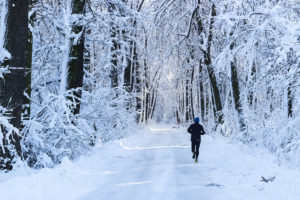
It’s a cold and gray winter day.
The last thing you want to do is exercise. You’d rather just stay inside and hibernate.
But getting up and moving could be exactly what you need to help fight the winter blahs.
“Staying active in the winter is very important, especially when you live in a place like West Michigan that doesn’t get a lot of sun,” said Matthew Axtman, DO, a Spectrum Health orthopedic sports medicine specialist.
“We know from research that individuals who are active and exercise tend to do a lot better during the winter months and are much healthier and happier.”
Increased activity can improve your mood and inspire more restful sleep, as well as boosting your immune system to fight off illness, he said.
Exercise can also be a big help for those who suffer from seasonal affective disorder, a form of depression that can be triggered by winter’s short and gray days.
Regardless of the season, Dr. Axtman recommends at least 30 minutes of exercise per day.
It can be hard to achieve this in the winter, but Dr. Axtman offered some helpful tips.
1. Get moving at home
“The gym is not for everyone,” Dr. Axtman said. “There’s a cost associated with it and a time commitment to travel there. And some people just don’t like working out in front of other people.”
The good news for those folks: “There are a lot of things you can do at home on your own that are cheap or even free,” he said.
Create your own gym, even with virtual instructors, right at home.
Dr. Axtman suggests going online to find free exercise videos that interest you. There’s pilates, yoga or even simple strength-training with exercise bands. You can also make up your own workout with exercises such as jumping jacks, situps, pushups or burpees.
“You don’t have to be running or biking,” Dr. Axtman said. “Anything to activate your muscles, get your heart pumping and your joints moving is going to be beneficial.”
2. Discover a fun winter sport
If you’re someone who likes to be outside in the winter, there are plenty of choices: cross country skiing, downhill skiing, ice skating, snowshoeing and more.
“We’re in a great place because there is so much access to winter sports,” Dr. Axtman said. “Go out there and try something. If you love it, run with it. And if you decide it’s not for you, there’s always something else to try.”
3. Dress for the weather
The important thing with any winter sport—running or biking outside in colder temperatures, for instance—is to dress appropriately.
“You want to layer up in the cold,” Dr. Axtman said. “You should be able to shed some layers to regulate your temperature, because you can overheat if you’re dressed too warmly.”
The base layer on your skin should be some kind of moisture-wicking fabric. Avoid cotton. Over that, you want layers to trap the heat—such as a heavier coat that’s wind- and water-resistant. Don’t forget gloves and a hat, as a lot of body heat can escape through extremities.
4. Indoors or outdoors, find a safe place
If you want to walk outside, always find a safe place with a clear surface.
“With the snow and slush and ice, you want to find a trail or pathway that is plowed and that is not going to cause injuries where you slip and fall,” he said.
If you don’t want to risk being outside, head to the mall to walk laps. Bring along a friend to keep you company and keep you motivated.
“It’s free and it’s a great option that’s going to get you going and keep you active,” Dr. Axtman said.
5. Aim for simplicity
Find simple ways to pack more steps into your day.
Take the stairs instead of the elevator. Park a little farther in the parking lot. Do a little extra housework. Dance to your favorite tunes.
“Think about ways you can easily add it into your day and you’re going to reap the benefits,” Dr. Axtman said.
 /a>
/a>
 /a>
/a>
 /a>
/a>
It was very helpful.
Encouraging.